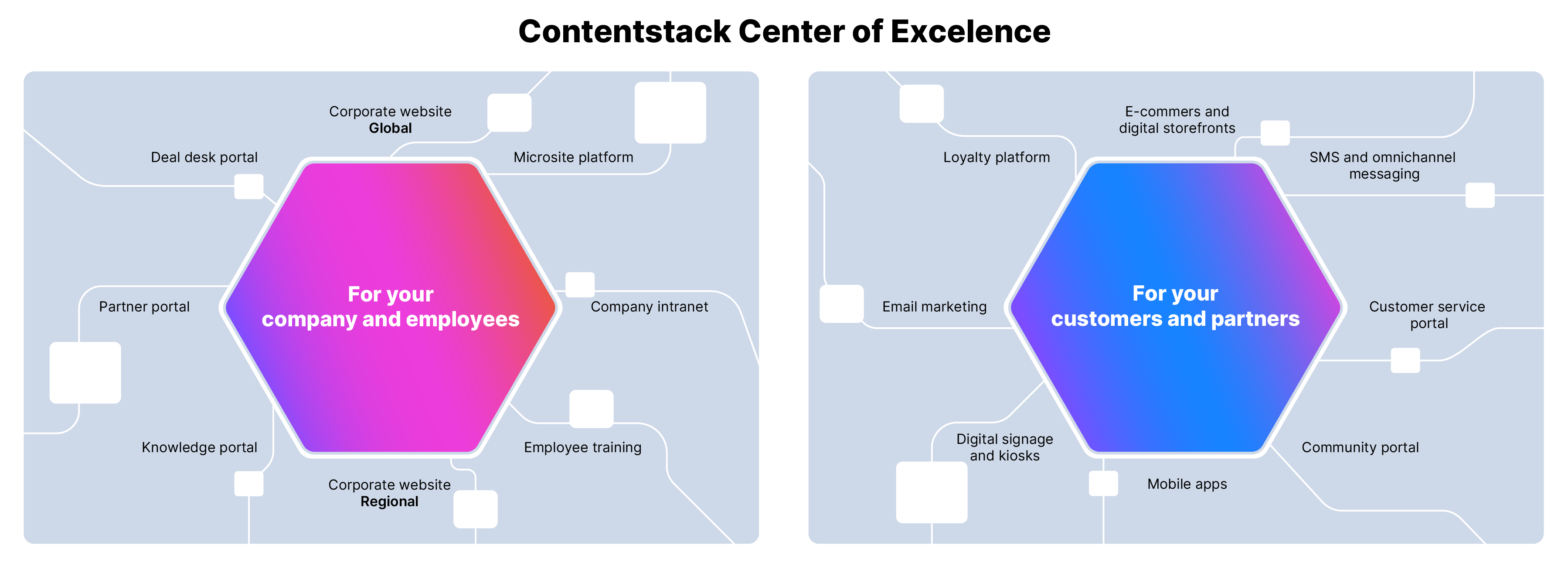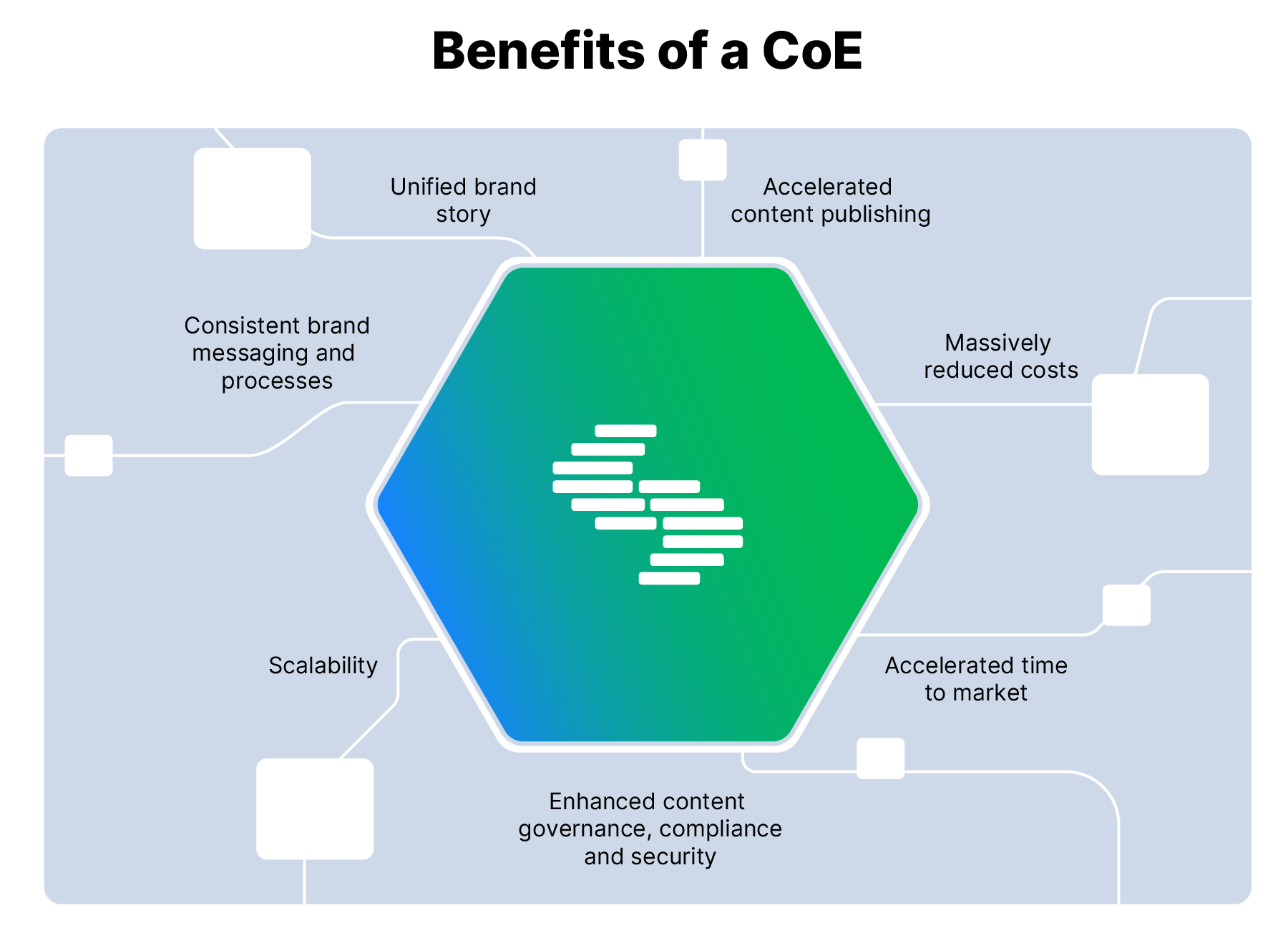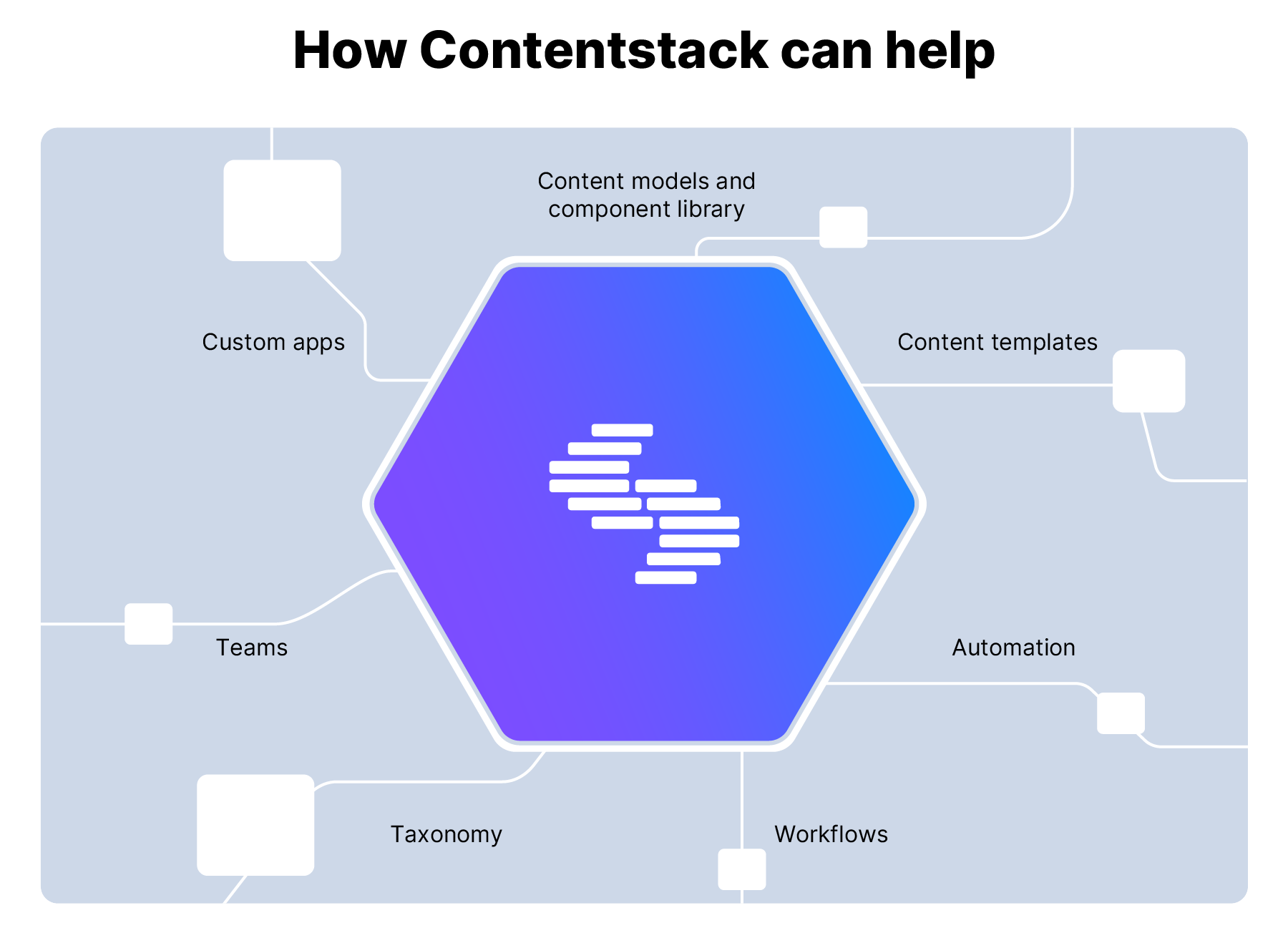Content Center of Excellence: How to achieve operational efficiency and content excellence at scale

Share

Faced with a fragmented user experience due to content silos across sub-brands, local markets, and business units, and an increasing need to increase content operational efficiencies, many high-functioning enterprise content teams are embracing a Content Center of Excellence (CoE) approach.
What is a Content Center of Excellence?
A Content CoE serves as the focal point for digital excellence and modernization within large enterprises and high-growth organizations. It empowers your teams to develop and share content effectively and integrates content strategy, technology, governance and innovation to enhance overall operational efficiency.
Its function is to align, streamline and improve the return on investment (ROI) of content efforts towards overarching business objectives.
The Content CoE also catalyzes organizational transformation as all business units are updated on the best future-fit technology and business practices.

What does a Content CoE include?
The components of a Content CoE cover a wide spectrum of digital content management requirements, fostering a culture of innovation, efficiency and continuous improvement. This can include:
- Reusable content models: Content models, component libraries, and templates for landing pages or websites among other resources.
- Best practice exchange: Sharing successful strategies and methodologies, such as migration and translation strategies, along with localization best practices across business units.
- Shared accelerators: Promoting the use of automation, integration best practices, and toolsets across different business units for enhanced efficiency and effectiveness.
- Content creation and management: The Content CoE emphasizes high-quality content creation, which involves ideation, drafting, editing and publishing processes.
- User experience and design: Prioritizing a superior user experience (UX) design across all channels ensures that content is not only accessible but also engaging for the end-user. This involves a deep understanding of user behavior and preferences and sharing best practices for applying design principles that enhance interactivity.
- Content personalization and optimization: Leveraging and sharing analytics and user data to personalize content delivery and optimize content performance across different channels is a key component of the modern CoE. This includes A/B testing, SEO optimization and content adjustments based on user engagement metrics.
- Security and compliance: Ensuring content management practices adhere to industry standards and regulations, such as GDPR, CCPA, etc. This includes implementing security protocols to protect sensitive information and privacy controls.
- Integration with other platforms and systems: A Content CoE enables the business by integrating the CMS with other composable technologies like platforms (DXPs), CRM, DAM, e-commerce platforms and whatever else the business requires, enabling a seamless flow of data and content across the digital ecosystem.

How to know you’re ready for a Content Center of Excellence?
What are the key indicators a business is ready to transition to a centralized Content CoE approach? If your business is experiencing these symptoms, you may be ready:
- Lots of “freemium” applications, one-off solutions and custom tools built by technical teams
- A glut of sites and microsites that nobody has touched in a long time
- Multiple brands each owning its own content ecosystem
- Multiple countries and local markets each owning its own content ecosystem
- Teams are asking for more functionality and more (expensive) third-party tools
Multiple CMSes and third-party application overload don’t just slow your organization down but are becoming increasingly expensive. One study found that in 2023, 73% of SaaS vendors increased their prices, ratcheting software spending up to an all-time high.
The 8 pain points you’re probably experiencing
If your company doesn’t have a Content CoE, obstacles ranging from inefficient content management systems to the inability to scale effectively can affect operational efficiency and profoundly impact a brand's market presence and customer engagement.
- Inefficient content management: Multiple CMSes and one-off solutions fragment and decentralize content, leading to inefficiencies in content creation, storage and distribution.
- Inconsistent messaging: When each business unit/team/brand/market follows its own workflows and guidelines, brand standards, messaging and voice are difficult to standardize and may lead to an inconsistent brand identity.
- Lack of collaboration: Multiple CMSes or one-off solutions prevent effective collaboration among teams, making it challenging to share resources, streamline workflows and ensure cross-departmental alignment.
- Difficulty tracking performance: Teams may struggle to gather comprehensive analytics and insights into content performance, making it challenging to measure ROI and make data-driven decisions or connect content strategy to business goals.
- Increased risk of errors and compliance issues: Risk of inconsistencies and compliance breaches due to different teams not adhering to standardized processes and guidelines (e.g. legal language, disclaimers, and other critical business information not being maintained)
- Higher costs: Maintaining multiple CMSes or one-off solutions incurs higher costs in licensing fees, maintenance, technical debt management and training.
- Limited scalability: Fragmented content processes make it challenging to create elegant solutions to business problems that enable the business to move quickly and efficiently, making it difficult for enterprises to adapt to market demands and innovate.
- Loss of competitive edge: Enterprises without a consolidated Content CoE risk falling behind competitors who can deliver a cohesive and impactful content experience.

Benefits of a Content Center of Excellence
Establishing a Content CoE is about overcoming the aforementioned pain points and seizing opportunities to elevate your organization's content strategy to new heights. By centralizing content management, governance and innovation, your business can unlock a range of benefits that directly contribute to your competitive advantage and operational excellence.
Below are some of the critical advantages that enterprises can expect when they implement a robust Content CoE framework:
- Accelerated content publishing: Implementing this framework can dramatically increase publishing speed, as evidenced by our customer, Golfbreaks, which achieved a 90% faster publishing rate. This speed is crucial for staying relevant and engaging with your audience in real time.
- Massively reduced costs: A robust Content CoE framework facilitates tech stack rationalization, which means fewer contracts and a consolidation of tools and technology. This consolidation not only reduces the costs associated with purchasing and maintaining multiple systems but also cuts down on training time and the repetition of processes unnecessarily. In the long run, this can significantly lower operational costs.
- Accelerated time to market: By fostering agility and innovation, a Content CoE allows businesses to bring their products and services to market much quicker. This increased speed to market is essential in today’s fast-paced business environment, where being first can be a significant advantage.
- Enhanced content governance, compliance, and security: With a structured framework, enterprises gain better control over their content, ensuring that governance policies are met and compliance and security standards are upheld. This is crucial for businesses operating in regulated industries or handling sensitive information.
- Scalability: Enterprises must manage large content volumes and quickly respond to changing content needs. A Content CoE framework is designed to scale with these changing needs, ensuring that companies can manage their content effectively, regardless of their size or content volume.
- Consistent brand messaging & processes: A unified content management approach helps maintain consistent brand messaging across all channels. This consistency is key to building trust and recognition with your audience.
- Unified brand story: Beyond messaging, a Content CoE ensures that every piece of content tells a part of your brand’s story, contributing to a cohesive narrative. This unified brand story is essential for creating a strong, relatable brand identity.

How Contentstack can help
From a technical perspective, Contentstack can be leveraged in many ways to help set up a Content CoE within a multi-brand, multi-site, or multi-digital property context.
Content Models & Component Library
- Access to standardized Content Models and a Component Library increases the efficiency of brand uniformity and content creation. A component can consist of many elements (banners, images, text fields, etc.).
Content Templates
- Content templates empower content teams to create content elements, and even entire websites, quickly and without involving developer resources.
If, for example, microsites are templatized and made available to your organization, content editors can spin up microsites in seconds — especially with Contentstack Launch.
Automation
- There are many ways automation can be leveraged to increase the effectiveness of the Content CoE — especially with Contentstack Automate. This can include pipelines of business logic, SEO optimization (for example, by automatically generating image metadata)and seamless integration with your preferred DAM or translation provider.
Workflows
- As part of a “site factory”, our customers have included workflow and governance guardrails as part of their default site template for any new content project. The workflows and governance rules manifest can be stored in source control alongside content models.
Taxonomy
- Taxonomies can be re-used across projects to standardize your information architecture and make content data and analytics measurable across multiple properties
Teams
- Teams can be shared across an entire organization or provisioned centrally via SSO across multiple orgs.
Custom Apps
- Developers can use Developer Hub to create “private apps” within their org, hosted on our Marketplace, and installed on any new Stack (content project). These private apps help companies create their own private marketplace for their teams to assemble pre-built functionality perfectly suited to their needs. These can be shared across the entire business to enable multi-site efficiency.
A different kind of company
If creating a Content CoE sounds daunting, don’t worry. Contentstack is uniquely positioned to provide the technical and strategic support your company may require to get the CoE up and running.
That includes our world-class Technical Services Organization (TSO) and Contentstack Academy. The TSO provides the deep technical expertise you want, while the Academy can be leveraged by your organization to get new users on-boarded in hours.
What do you need to be prepared for?
- Implement and document best practices: A Center of Excellence starts with a clear understanding and implementation of best practices that will be shared across the organization. Our TSO is here to help you understand what’s needed and why.
- Requires clear ownership and business support: It is best to have a single team responsible for best practices, technology consolidation, monitoring new features and how to make the most of Contentstack.
- Change management: Teams will naturally resist changing how they’ve always done things. But the potential payoff is huge.
- “Selling in” the solution to other teams: Proving the value and future benefits will be crucial to creating momentum for the Center of Excellence. Watch this presentation by Jurre van Ruth of PostNL to see an example of how to inspire the business to embrace the innovation offered by a company-wide implementation of Contentstack.
For a great real-world example of how to work with a Content CoE, check out the Icelandair case study to see how they did it and what the airline has achieved.
Conclusion
Taking the step towards a centralized content strategy requires careful planning, clear ownership and a commitment to change management. However, the rewards for operational excellence and market responsiveness are profound. Don’t let the complexities deter you. Contentstack provides the expertise and resources necessary to make your Content CoE a reality. Whether it's leveraging our Technical Services Organization, Contentstack Academy or our versatile platform capabilities, we’re dedicated to guiding your business through this transformation.
If creating a Content CoE sounds right for your business, or if you want to take your content strategy to the next level, now is the time to act. Contact your Customer Success Manager (CSM) at Contentstack to learn more about how we can support your journey toward a more cohesive, efficient and impactful content strategy.



